Council Tax: challenges and changes statistical summary
Published 5 August 2021
This release includes statistics on challenges against and changes made to the England and Wales Council Tax valuation lists between 1 April 1993 and 31 March 2021.
|
Responsible Statistician |
Statistical enquiries |
Date of next publication |
|
Claire Lyall |
Summer 2022 |
1. Headline facts and figures – 1 April 2020 to 31 March 2021
Challenges against and changes made to the Council Tax Valuation Lists for England (1993) and Wales (2005) in 2020 to 2021:
The number of received challenges in 2020 to 2021 was
40,620
Down from 43,940 in 2019 to 2020
The number of resolved challenges in 2020 to 2021 was
38,070
Down from 42,120 in 2019 to 2020
The number of outstanding challenges as at 31 March 2021 was
11,330
Up from 8,790 in 2019 to 2020
The percentage of challenges resulting in no change to the Council Tax band in 2020 to 2021 was
60.3%
Down from 61.6% in 2019 to 2020
The number of amendments to the Council Tax lists in 2020 to 2021 was
60,590
Down from 65,580 in 2019 to 2020
2. About these statistics
The statistics in this publication relate to England and Wales only. The valuation law and practice in Scotland and Northern Ireland are different and valuations in those countries are not carried out by the Valuation Office Agency (VOA).
The statistics are available at national, regional and billing authority level.
This publication is released in support of bringing greater transparency to VOA functions. The data are also used to inform government policy and conduct analyses to support the operations of the VOA.
3. Challenges against the Council Tax Valuation Lists for England (1993) and Wales (2005)
These are challenges against the entries in the Council Tax Valuation Lists for England (1993) and Wales (2005). For England before 1 April 2008 and for Wales, this consists of band reviews and appeals. For England from 1 April 2008, this consists of band reviews, proposals, and of these proposals, the number which were sent to the Valuation Tribunal Service for appeal, referred to as appeals.
Figure 1: Number of challenges received and resolved in England and Wales, 1 April 2020 to 31 March 2021
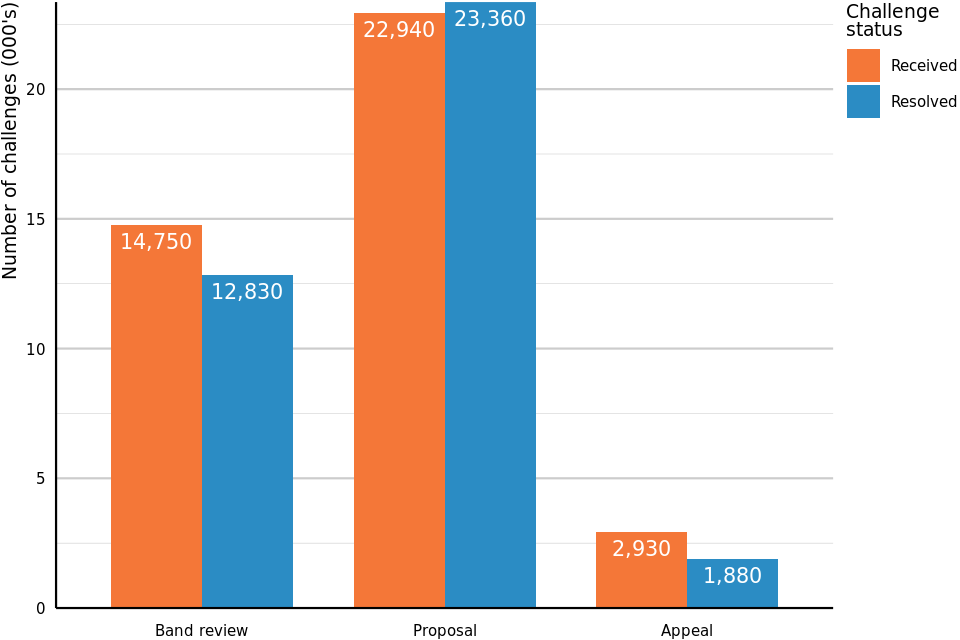
Figure 1
Source: Tables CTCAC1.2 to CTCAC1.4
Figure notes:
Counts are rounded to the nearest 10.
The number of challenges received and resolved between 1 April 2020 and 31 March 2021 are shown in Figure 1.
The resolved figures are the number of challenges that were resolved between 1 April 2020 and 31 March 2021; not all of these challenges will have been received during this time because some of them will have been outstanding from previous years.
Of the 40,620 challenges received by VOA in 2020 to 2021, there were 22,940 (56.5%) proposals, 14,750 (36.3%) band reviews and 2,930 (7.2%) appeals.
Of the 38,070 challenges resolved by VOA in 2020 to 2021, there were 23,360 (61.3%) proposals, 12,830 (33.7%) band reviews and 1,880 (4.9%) appeals. Of these:
- 60.3% resulted in no change to the council tax band
- 30.7% resulted in a reduction to the council tax band
- 0.1% resulted in an increase to the council tax band
- 6.4% resulted in a property being deleted from the Council Tax list
- 1.1% resulted in a new entry to the list
- 1.5% resulted in either a property being split or multiple properties being merged
Figure 2: Number of challenges outstanding in England and Wales, 31 March 2021

Figure 2
Source: Tables CTCAC1.2 to CTCAC1.4
Figure notes:
Counts are rounded to the nearest 10.
The number of challenges outstanding at 31 March 2021 is shown in Figure 2.
Of the 11,330 challenges outstanding at 31 March 2021, there were 3,730 (32.9%) band reviews, 3,920 (34.6%) proposals and 3,680 (32.5%) appeals.
4. Band reviews
Band reviews were introduced in the 2004 to 2005 financial year. A band review is carried out when the taxpayer brings a potential inaccuracy to the attention of the VOA. The taxpayer must provide sufficient evidence to the VOA to show why they consider their council tax band to be incorrect. The VOA will investigate the matter and inform the taxpayer of the outcome. The taxpayer does not have the right to appeal the outcome of a band review.
Figure 3: Number of band reviews received and resolved in England, 1 April 2004 to 31 March 2021

Figure 3
Source: Tables CTCAC4.1 & CTCAC4.2
Figure 4: Number of band reviews received and resolved in Wales, 1 April 2004 to 31 March 2021
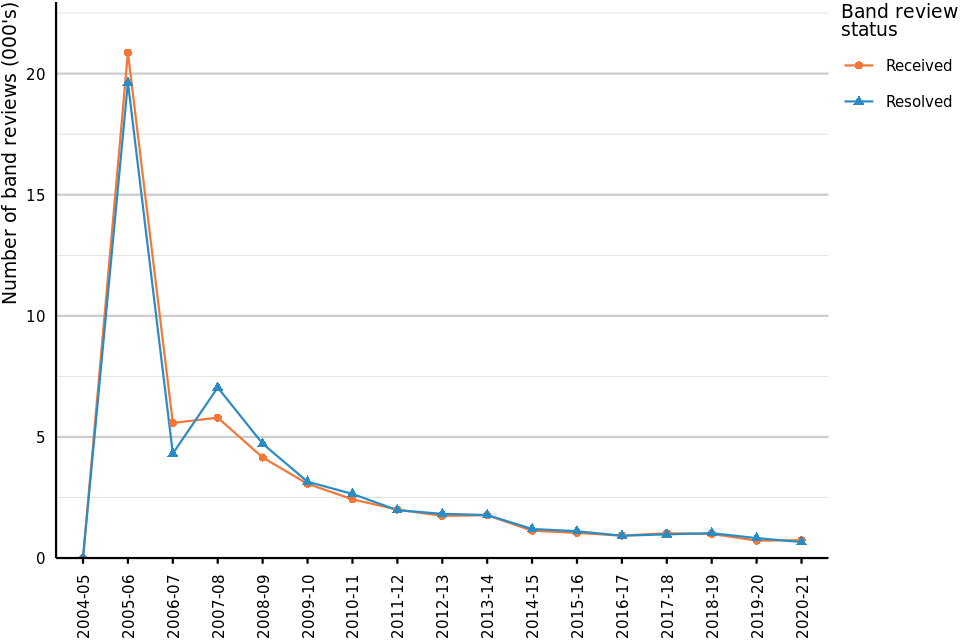
Figure 4
Source: Tables CTCAC4.1 & CTCAC4.2
Figures 3 and 4 show the number of band reviews received between 1 April 2004 and 31 March 2021. The numbers of band reviews received and resolved in each year are generally consistent with one another. Following the introduction of a new Council Tax list on 1 April 2005 in Wales, there was an increase in the number of band reviews received for Welsh properties, which constituted most of the total band reviews received in 2005 to 2006. Media campaigns began in early 2007 which drew public attention to the process of taxpayers challenging their council tax band, consequently, the number of band reviews increased. From October 2015, a change in VOA standard practice to only raise band reviews when sufficient evidence is brought to its attention likely contributed to the reduction in band reviews. Since this time, the number of band reviews received and resolved has been relatively stable. In 2020 to 2021, the VOA received 14,750 band reviews, which is slightly higher than the 13,650 received in 2019 to 2020. The VOA resolved 12,830 band reviews in 2020 to 2021, which is 11% lower than the 14,360 resolved in 2019 to 2020.
4.1 Outcomes of band reviews
Band reviews can either result in a Council Tax band increase, a Council Tax band decrease or no change to the Council Tax band. Between 1 April 2020 and 31 March 2021, 53.8% of band reviews resolved resulted in no change to the Council Tax Band, 46.1% resulted in a reduction to the band and 0.1% resulted in an increase to the band.
Figure 5: Outcomes of band reviews resolved in England and Wales, 1 April 2004 to 31 March 2021

Figure 5
Source: Table CTCAC4.2
Figure notes:
Please note that the percentage labels are displayed for the outcomes of ‘Band decreased’ and ‘Band unchanged’ only; therefore, the percentages will not sum to 100% for each year.
Table 1: Outcomes of band reviews resolved in England and Wales, 1 April 2004 to 31 March 2021
|
Financial year |
Band increased |
Band decreased |
Band unchanged |
Total |
|
2004-05 |
10 |
260 |
410 |
680 |
|
2005-06 |
310 |
13,420 |
20,270 |
34,000 |
|
2006-07 |
230 |
15,690 |
30,270 |
46,190 |
|
2007-08 |
200 |
30,040 |
62,100 |
92,340 |
|
2008-09 |
110 |
24,010 |
61,780 |
85,900 |
|
2009-10 |
80 |
16,460 |
44,010 |
60,560 |
|
2010-11 |
40 |
15,180 |
44,660 |
59,880 |
|
2011-12 |
40 |
14,060 |
43,070 |
57,160 |
|
2012-13 |
30 |
13,200 |
46,960 |
60,190 |
|
2013-14 |
10 |
10,020 |
28,650 |
38,690 |
|
2014-15 |
– |
6,120 |
11,950 |
18,080 |
|
2015-16 |
10 |
5,050 |
8,920 |
13,990 |
|
2016-17 |
10 |
4,580 |
7,470 |
12,060 |
|
2017-18 |
10 |
4,880 |
7,100 |
11,990 |
|
2018-19 |
10 |
6,960 |
9,340 |
16,310 |
|
2019-20 |
20 |
6,350 |
8,000 |
14,360 |
|
2020-21 |
20 |
5,910 |
6,910 |
12,830 |
Source: Table CTCAC4.2
Table notes:
Counts are rounded to the nearest 10 with counts of 0 being reported as 0 and counts fewer than 5 reported as negligible and denoted by ‘–’. Totals may not sum due to rounding.
Figure 5 and Table 1 show the outcomes of band reviews resolved between 1 April 2004 and 31 March 2021. Between 2005 to 2006 and 2012 to 2013, the percentage of band reviews resulting in no change to the band steadily increased. From 2015 to 2016, a change in VOA standard practice (introduced in October 2015), to only raise band reviews when sufficient evidence is brought to its attention, likely contributed to the percentage of band reviews resulting in no change to the band decreasing year on year. In 2020 to 2021, 46.1% resulted in a band decrease and 53.8% resulted in no change to the band, in 2019 to 2020, the figures were 44.2% and 55.7% respectively.
4.2 Outstanding band reviews
Figure 6: Number of band reviews outstanding in England and Wales, 31 March 2005 to 31 March 2021
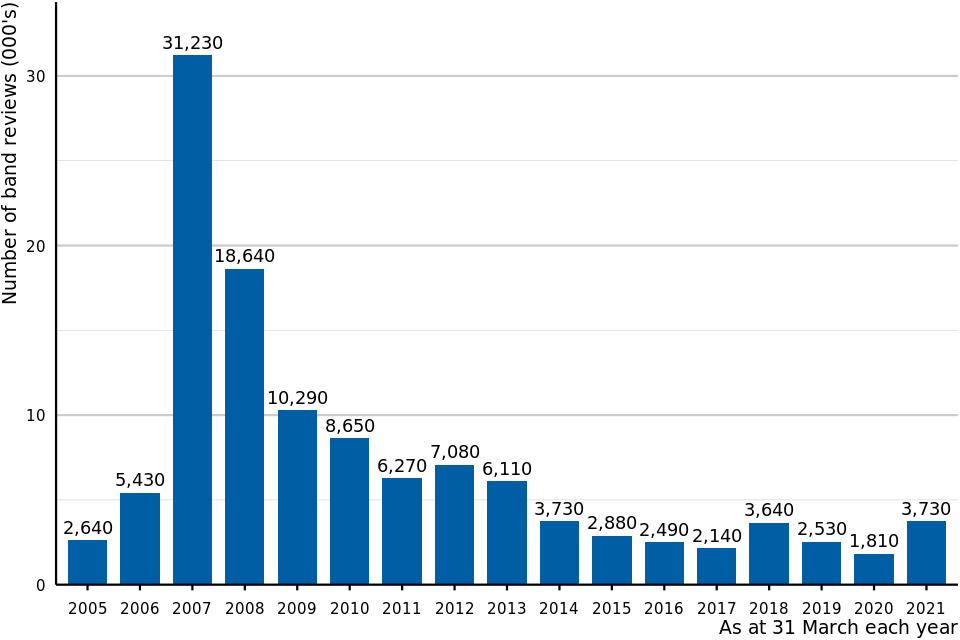
Figure 6
Source: Table CTCAC4.3
Figure notes:
Counts are rounded to the nearest 10.
Figure 6 shows the number of band reviews outstanding at 31 March of each year from 2005 to 2021. The number of band reviews outstanding rose sharply from their introduction in the 2004 to 2005 financial year until 2007, but since 2007 the number outstanding has been steadily decreasing. However, in 2021, there were 3,730 band reviews outstanding at 31 March 2021 which is just over double the 1,810 outstanding at 31 March 2020.
5. Proposals in England since 1 April 2008
A proposal is a formal challenge to a Council Tax list entry. There are limited circumstances under which a proposal can be accepted; for example, a new occupier can make a proposal within the first six months of becoming the taxpayer for their home. If the taxpayer has a statutory right to make a proposal, unlike band reviews, they do not need to provide evidence upfront that the banding is wrong. In England since 1 April 2008, the VOA will review the proposal and provide the taxpayer with a written decision, usually within two months; the taxpayer then has up to three months to appeal to a Valuation Tribunal (VT). In Wales, and in England before 1 April 2008, the VOA transmits all proposals to the Valuation Tribunal Service (VTS) for appeal within 30 days of receiving them. Therefore, only proposals in England since 1 April 2008 are included in these statistics.
Figure 7: Number of proposals received and resolved in England, 1 April 2008 to 31 March 2021

Figure 7
Source: Tables CTCAC5.1 & CTCAC5.2
Figure 7 shows that the number of proposals received between 1 April 2008 and 31 March 2021. The numbers of proposals received and resolved in each year mirror one another consistently. There has been fluctuation in the number of proposals received over the years; numbers started to increase in 2012 to 2013, but since 2016 to 2017 there has been a general decline, except for an uptick in 2019 to 2020. In 2020 to 2021 the number of proposals received was 22,940, which is 13% lower than the 26,400 received 2019 to 2020. Similarly, 23,360 proposals were resolved in 2020 to 2021, which is slightly lower than the 24,590 resolved in 2019 to 2020.
5.1 Outcomes of proposals
Proposals can result in a Council Tax band increase, a Council Tax band decrease, no change to the Council Tax band, a new entry to the Council Tax list, a deleted entry from the list or a property on the list being either split or merged. Of the proposals resolved between 1 April 2020 and 31 March 2021:
- 64.5% resulted in no change to the Council Tax Band
- 22.4% resulted in a reduction to the band
- 0.1% resulted in an increase to the band
- 9.2% resulted in a property being deleted from the Council Tax list
- 1.6% resulted in a new entry to the list
- 2.2% resulted in either a property being split or multiple properties being merged.
Figure 8: Outcomes of proposals resolved in England, 1 April 2008 to 31 March 2021

Figure 8
Source: Table CTCAC5.2
Figure notes:
Please note that the percentage labels are only displayed for the outcomes of ‘Band decreased’ and ‘Band unchanged’, as well as for any other outcome that accounts for at least 15% of the total in the year. Therefore, the percentages will not sum to 100% for each year.
Table 2: Outcomes of proposals resolved in England, 1 April 2008 to 31 March 2021
|
Financial year |
Band increased |
Band decreased |
Band unchanged |
Deleted |
Split/merger |
New entry |
Total |
|
2008-09 |
10 |
5,210 |
13,760 |
1,990 |
570 |
170 |
21,710 |
|
2009-10 |
10 |
5,740 |
14,610 |
1,790 |
390 |
110 |
22,640 |
|
2010-11 |
10 |
4,830 |
14,340 |
1,980 |
480 |
120 |
21,750 |
|
2011-12 |
10 |
4,450 |
13,310 |
2,020 |
570 |
190 |
20,550 |
|
2012-13 |
10 |
4,350 |
13,450 |
2,000 |
470 |
60 |
20,340 |
|
2013-14 |
10 |
4,950 |
18,360 |
4,510 |
730 |
90 |
28,640 |
|
2014-15 |
10 |
5,140 |
19,610 |
5,570 |
990 |
180 |
31,490 |
|
2015-16 |
20 |
4,720 |
20,700 |
6,120 |
1,300 |
330 |
33,180 |
|
2016-17 |
20 |
5,030 |
21,550 |
7,250 |
1,390 |
680 |
35,920 |
|
2017-18 |
20 |
4,440 |
15,710 |
2,930 |
770 |
330 |
24,190 |
|
2018-19 |
20 |
4,140 |
12,170 |
1,800 |
500 |
220 |
18,850 |
|
2019-20 |
50 |
5,140 |
16,090 |
2,170 |
690 |
450 |
24,590 |
|
2020-21 |
30 |
5,240 |
15,060 |
2,160 |
500 |
380 |
23,360 |
Source: Table CTCAC5.2
Table notes:
Counts are rounded to the nearest 10 with counts of 0 being reported as 0. Totals may not sum due to rounding.
Figure 8 and Table 2 show that the percentage of proposals resulting in each outcome in 2020 to 2021 has remained similar to figures from previous years. In 2020 to 2021, 22.4% of proposals resulted in a band decrease and 64.5% resulted in no change to the band. In 2019 to 2020, these figures were 20.9% and 65.4% respectively.
5.2 Outstanding proposals
Figure 9: Number of proposals outstanding in England, 31 March 2009 to 31 March 2021
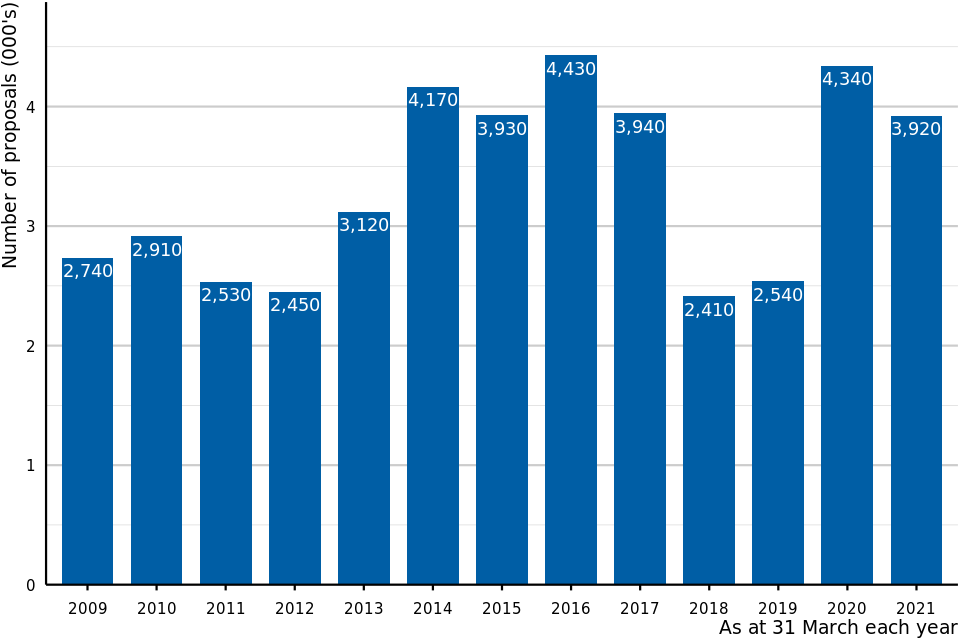
Figure 9
Source: Table CTCAC5.3
Figure notes:
Counts are rounded to the nearest 10.
Figure 9 shows the number of proposals outstanding at 31 March each year from 2009 to 2021. Over the years, these numbers generally follow the same pattern as the number of proposals received and resolved. Consequently, the number of outstanding proposals has decreased in 2021, due to a recent decrease in the number of proposals received. There were 3,920 proposals outstanding at 31 March 2021; this is 10% lower than the 4,340 outstanding at 31 March 2020.
6. Appeals in England from 1 April 2008
In England since 1 April 2008, the VOA will review a proposal and provide the taxpayer with a written decision, usually within two months; the taxpayer then has up to three months to appeal this decision to an independent Valuation Tribunal (VT). In order to demonstrate the connection between proposals and appeals, appeals are counted using the date that their associated proposal was resolved.
Figure 10: Percentage of proposal decisions which were appealed in England, 1 April 2008 to 31 March 2021

Figure 10
Source: Table CTCAC5.2
Figure 10 shows the percentage of proposals resolved that were subsequently appealed, by the year that the proposal was resolved. Over the years, these percentages have remained fairly steady, ranging from 7.5% to 11.2%. Of the 23,360 proposals resolved in 2020 to 2021, 7.9% were subsequently appealed; this is lower than the 9.5% in 2019 to 2020.
6.1 Outcomes of appeals in England from 1 April 2008
Appeals are often withdrawn or settled before reaching the Valuation Tribunal.
Figure 11: Percentage of appeals resolved without a tribunal and resolved at tribunal in England, 1 April 2008 to 31 March 2021
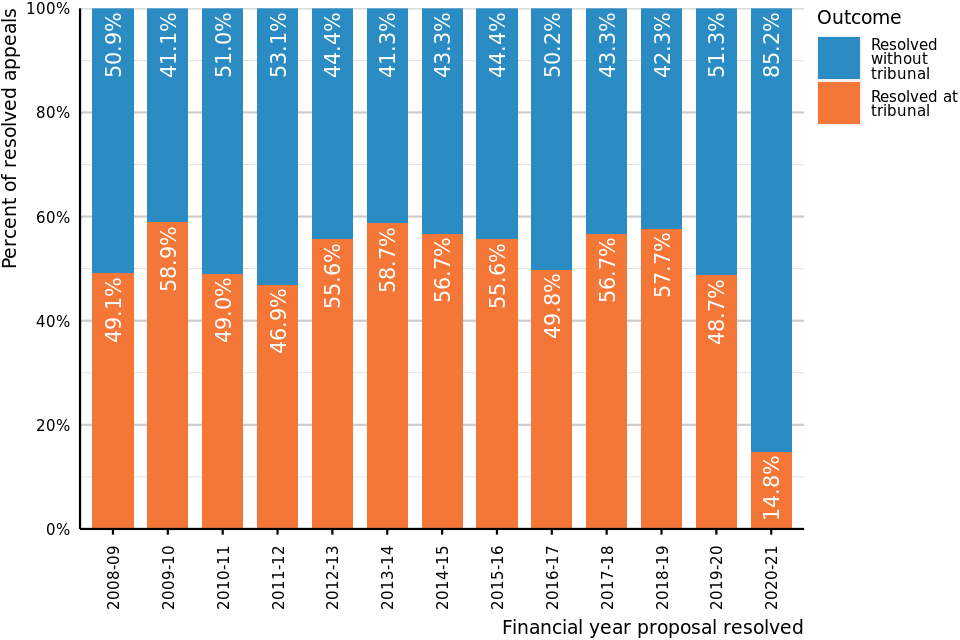
Figure 11
Source: Table CTCAC5.2
Figure 11 shows the percentage of appeals resolved without a tribunal and at tribunal, by the year that the associated proposal was resolved. Until 2019 to 2020, these figures were split fairly evenly in each year. However, in 2020 to 2021 the percentage of appeals resolved at tribunal dropped to 14.8%. This is likely due to tribunal courts being closed for much of the financial year due to the Covid-19 pandemic.
Figure 12: Proposals resolved in England from 1 April 2020 to 31 March 2021 with the action taken by the taxpayer following the issuing of the decision notice

Figure 12
Source: Table CTCAC5.2
Figure notes:
Counts are rounded to the nearest 10.
In 2020 to 2021, 23,360 proposals were resolved (figures 7 and 12) and 1,850 (7.9%) of those proposals were subsequently appealed (figures 10 and 12). Of the proposals that were subsequently appealed, 120 were resolved as at 31 March 2021 (table 2 and figure 12); 100 (85.2%) of them were resolved without a tribunal and 20 (14.8%) required a tribunal (figures 11 and 12).
Appeals, like proposals, can result in a Council Tax band increase, a Council Tax band decrease, no change to the Council Tax band, a new entry to the Council Tax list, a deleted entry from the list, or a property on the list being either split or merged. Of the resolved appeals where the associated proposal was resolved in 2020 to 2021:
- 46.1% resulted in no change to the Council Tax Band
- 37.4% resulted in a reduction to the band
- none resulted in an increase to the band
- 13.9% resulted in a property being deleted from the Council Tax list
- none resulted in a new entry to the list
- 2.6% resulted in either a property being split or multiple properties being merged
Figure 13: Outcomes of resolved appeals in England, 1 April 2008 to 31 March 2021

Figure 13
Source: Table CTCAC5.2
Figure notes:
Please note that the percentage labels are displayed for the outcomes of ‘Band decreased’ and ‘Band unchanged’ only. Therefore, the percentages will not sum to 100% for each year.
Figure 13 shows the outcomes of resolved appeals since 1 April 2008, by the year that the associated proposal was resolved. In 2020 to 2021, 37.4% of proposals resulted in a band decrease, 46.1% resulted in no change to the band and 13.9% resulted in a deletion. In 2019 to 2020, these figures were 30.8%, 62.4% 4.8% and respectively.
6.2 Outstanding appeals
Table 3: Number of appeals outstanding in England by the financial year that the associated proposal was resolved, 1 April 2008 to 31 March 2021
|
Financial year proposal resolved |
Outstanding appeals |
|
2008-09 |
0 |
|
2009-10 |
0 |
|
2010-11 |
0 |
|
2011-12 |
0 |
|
2012-13 |
– |
|
2013-14 |
0 |
|
2014-15 |
– |
|
2015-16 |
– |
|
2016-17 |
– |
|
2017-18 |
10 |
|
2018-19 |
20 |
|
2019-20 |
820 |
|
2020-21 |
1,730 |
|
Total |
2,580 |
Source: Table CTCAC5.2
Table notes:
Counts are rounded to the nearest 10 with counts of 0 being reported as 0 and counts fewer than 5 reported as negligible and denoted by ‘–’.
Table 3 shows the number of appeals outstanding at 31 March 2021, by the financial year that the associated proposal was resolved. At 31 March 2021, 2,580 appeals were outstanding in England. Of these, 1,730 (67.1%) were from proposals resolved in 2020 to 2021 and 820 (31.6%) were from proposals resolved in 2019 to 2020. A small number of complex cases remain outstanding from earlier years.
7. Appeals in Wales
The proposal system in Wales differs from the system in England that was introduced on 1 April 2008. All proposals received in Wales, if unresolved, are automatically transmitted as appeals to Valuation Tribunal Service (VTS) within thirty days of receiving them.
Figure 14: Number of appeals received and resolved in Wales, 1 April 1993 to 31 March 2021
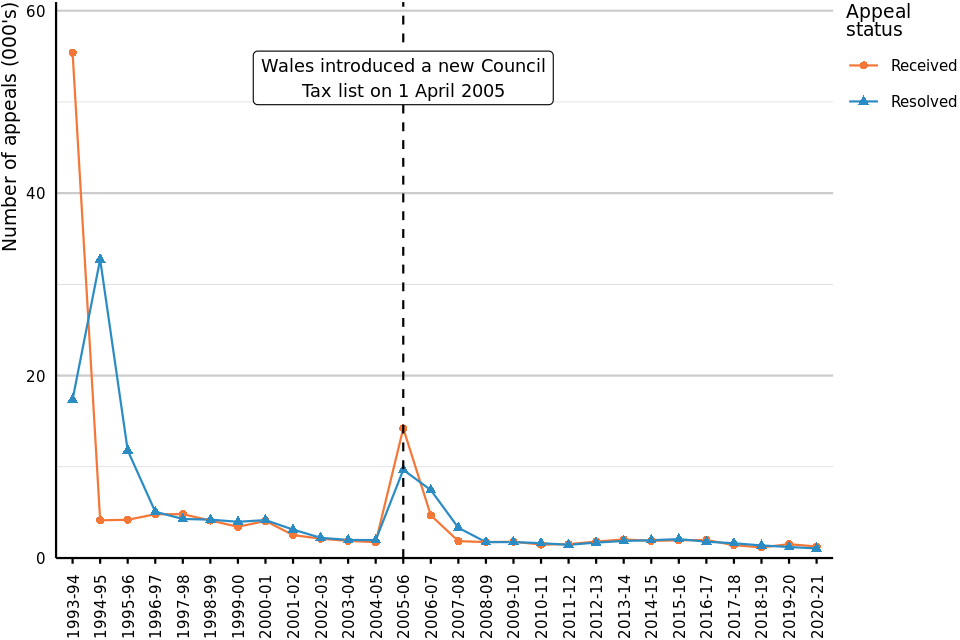
Figure 14
Source: Table CTCAC6.2
Figure 14 shows the spike of appeals that were submitted in 2005 to 2006. This was due to the new Council Tax list that was introduced in Wales on 1 April 2005.
Figure 15: Number of appeals received and resolved in Wales, 1 April 2016 to 31 March 2021
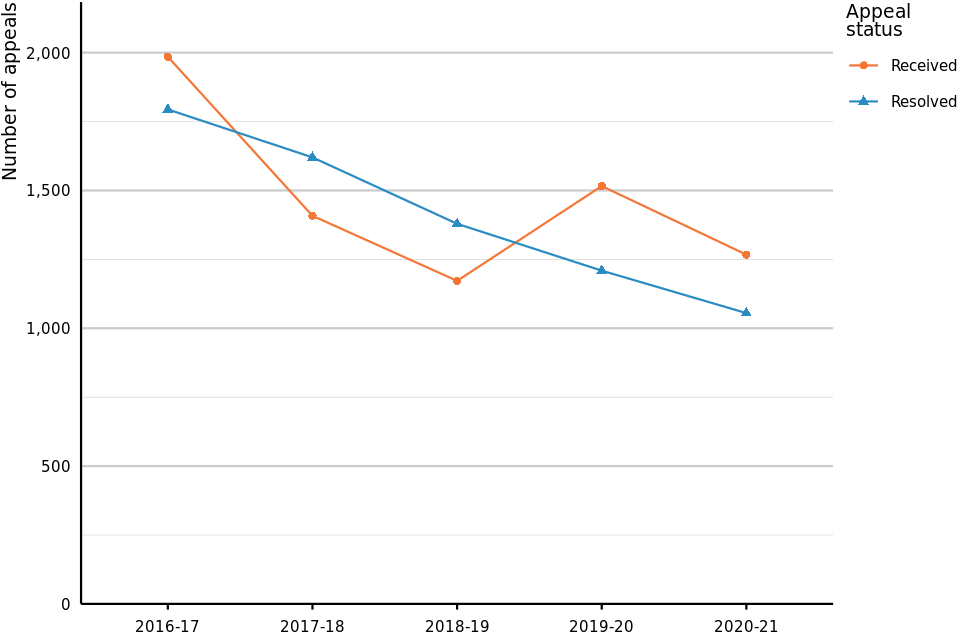
Figure 15
Source: Table CTCAC6.2
Figure 15 shows the number of appeals received and resolved between 1 April 2015 and 31 March 2021. These numbers have been decreasing over the years, however, there was an uptick in the number of appeals received in 2019 to 2020.
7.1 Outcomes of appeals in Wales
Figure 16: Percentage of appeals resolved without a tribunal and resolved at tribunal in Wales, 1 April 2005 to 31 March 2021

Figure 16
Source: Table CTCAC6.2
Figure notes:
Please note that in years where the outcome of ‘Resolved at tribunal’ accounts for less than 10% of the total, the percentage labels are displayed for the outcome of ‘No tribunal required’ only. Therefore, the percentages will not sum to 100% for these years.
Figure 16 shows the percentage of appeals resolved without a tribunal and resolved at tribunal in Wales from 1 April 1993 to 31 March 2021. In each year, the percentage of appeals resolved without a tribunal is significantly higher than the percentage resolved at tribunal, ranging from 67.6% to 92.1%. The year with the highest percentage of appeals that were resolved at tribunal was 2018 to 2019, with 32.4%. Of the 1,060 appeals resolved in 2020 to 2021 in Wales, 88.8% were resolved without a tribunal and 11.2% required a tribunal.
Of the appeals resolved in Wales between 1 April 2020 and 31 March 2021:
- 45.1% resulted in no change to the Council Tax Band
- 25.1% resulted in a reduction to the band
- none resulted in an increase to the band
- 22.3% resulted in a property being deleted from the Council Tax list
- 1.8% resulted in a new entry to the list
- 5.7% resulted in either a property being split or multiple properties being merged.
Figure 17: Outcomes of appeals resolved in Wales, 1 April 1993 to 31 March 2021
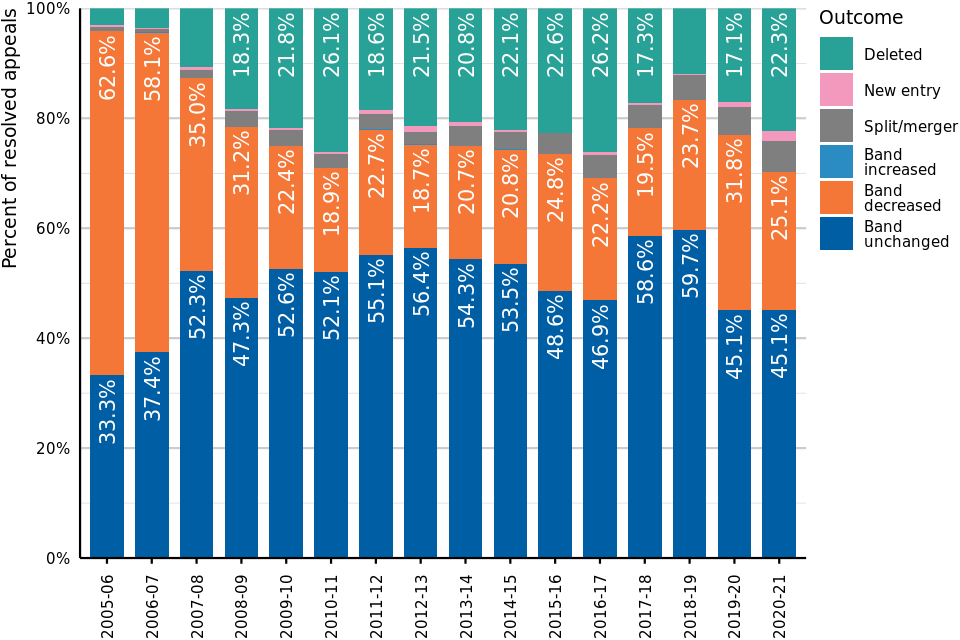
Figure 17
Source: Table CTCAC6.2
Figure notes:
Please note that the percentage labels are only displayed for the outcomes of ‘Band decreased’ and ‘Band unchanged’, as well as for any other outcome that accounts for at least 15% of the total in the year. Therefore, the percentages will not sum to 100% for each year.
Table 4: Outcomes of appeals resolved in Wales, 1 April 2005 to 31 March 2021
|
Financial year |
Band increased |
Band decreased |
Band unchanged |
Deleted |
Split/merger |
New entry |
Total |
|
2005-06 |
10 |
6,050 |
3,220 |
300 |
60 |
40 |
9,670 |
|
2006-07 |
10 |
4,330 |
2,790 |
260 |
40 |
30 |
7,450 |
|
2007-08 |
0 |
1,160 |
1,730 |
360 |
50 |
20 |
3,320 |
|
2008-09 |
0 |
550 |
830 |
320 |
50 |
10 |
1,750 |
|
2009-10 |
0 |
390 |
920 |
380 |
50 |
10 |
1,750 |
|
2010-11 |
0 |
310 |
850 |
430 |
40 |
10 |
1,630 |
|
2011-12 |
– |
330 |
800 |
270 |
40 |
10 |
1,450 |
|
2012-13 |
– |
320 |
960 |
360 |
40 |
20 |
1,690 |
|
2013-14 |
0 |
390 |
1,020 |
390 |
70 |
10 |
1,870 |
|
2014-15 |
– |
410 |
1,040 |
430 |
60 |
10 |
1,950 |
|
2015-16 |
0 |
520 |
1,010 |
470 |
80 |
– |
2,070 |
|
2016-17 |
0 |
400 |
840 |
470 |
80 |
10 |
1,790 |
|
2017-18 |
– |
320 |
950 |
280 |
70 |
10 |
1,620 |
|
2018-19 |
0 |
330 |
820 |
160 |
60 |
– |
1,380 |
|
2019-20 |
0 |
390 |
550 |
210 |
60 |
10 |
1,210 |
|
2020-21 |
0 |
270 |
480 |
240 |
60 |
20 |
1,060 |
Source: Table CTCAC6.2
Table notes:
Counts are rounded to the nearest 10 with counts of 0 being reported as 0 and counts fewer than 5 reported as negligible and denoted by ‘–’. Totals may not sum due to rounding.
Figure 17 and table 4 show the outcomes of resolved appeals in Wales from 1 April 2005 to 31 March 2021. Due to the relatively small number of appeals resolved each year (table 4), the percentages of appeals resulting in each outcome vary significantly over the years.
7.2 Appeals outstanding in Wales
Figure 18: Number of appeals outstanding in Wales, 31 March 1994 to 31 March 2021

Figure 18
Source: Table CTCAC6.2
Figure notes:
Counts are rounded to the nearest 10.
Figure 18 shows the brief spike in outstanding appeals after the introduction of the new Council Tax list on 1 April 2005.
Figure 19: Number of appeals outstanding in Wales, 31 March 2017 to 31 March 2021

Figure 19
Source: Table CTCAC6.2
Figure notes:
Counts are rounded to the nearest 10.
Figure 19 shows the number of appeals outstanding in Wales from 31 March 2017 to 31 March 2021. The number of appeals outstanding has fluctuated over these years; there were 960 appeals outstanding at 31 March 2021, which is 28% higher than the 750 outstanding at 31 March 2020.
8. Amendments to the Council Tax Valuation Lists for England (1993) and Wales (2005)
Amendments are changes that have been made as a result of either a challenge or a report. A report happens when the VOA has been made aware of a change to the property that warrants a change in the valuation list entry (for example, when a house is extended and subsequently sold). This may result in a band increase, band decrease or no change to the Council Tax band; even when the band is unchanged, property attribute details (e.g. number of bedrooms) may have been updated on the VOA’s administrative system.
In this publication, amendments do not include properties that have been deleted from the CT Valuation Lists, inserted to the CT Valuation Lists or properties amended on the CT Valuation Lists as a result of being split or merged. These will be reported in our upcoming Council Tax Stock of Properties release, to be published on Thursday 23 September 2021.
Figure 20: Number of amendments to Council Tax Valuation Lists in England and Wales, 1 April 2020 to 31 March 2021
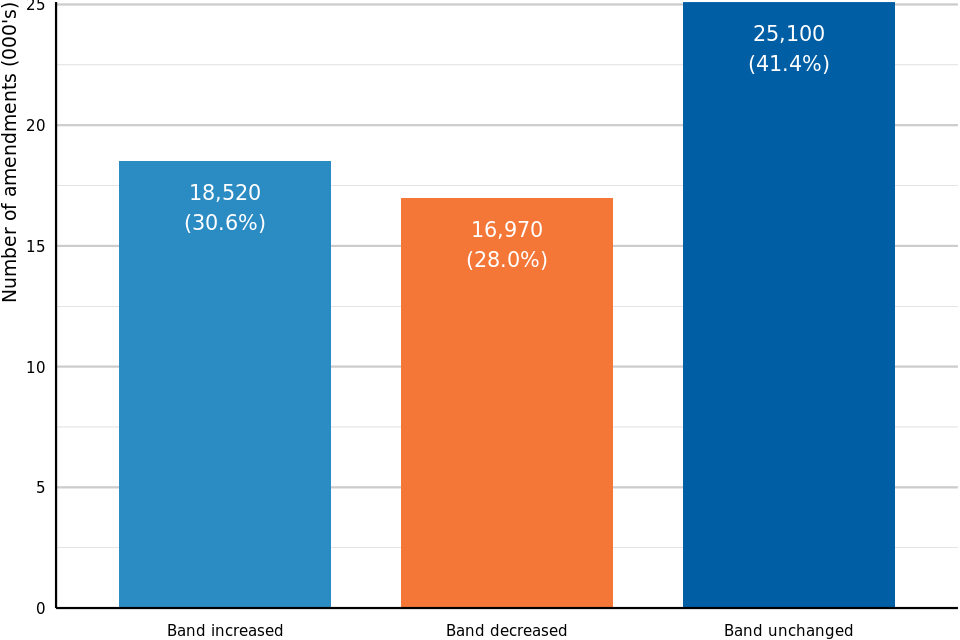
Figure 20
Source: Table CTCAC2.1
Figure 20 shows the amendments made to the Council Tax Valuation Lists between 1 April 2020 and 31 March 2021 as a result of both challenges and reports. Of the 60,590 amendments, 30.6% resulted in an increased council tax band, 28.0% resulted in a reduction to the council tax band and 41.4% resulted in no change to the council tax band.
9. Further Information
Further information about the data and methodology presented in this summary can be found in the Background Information.
GOV.UK has more information on:
- how domestic properties are assessed for Council Tax bands
- how to check your Council Tax band
- how to challenge your Council Tax band
Timings of future releases are regularly placed on the VOA research and statistics calendar.
